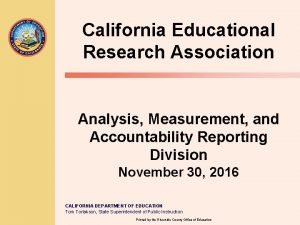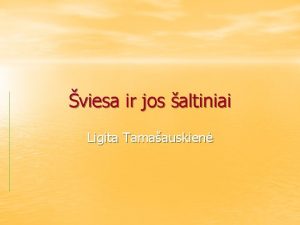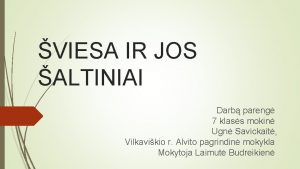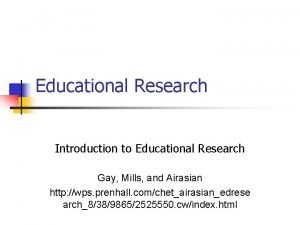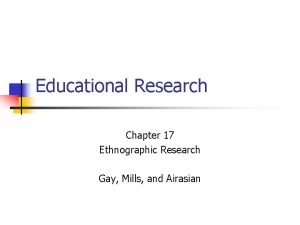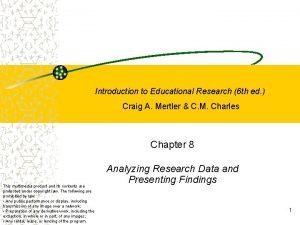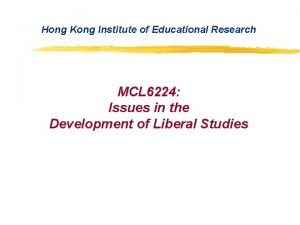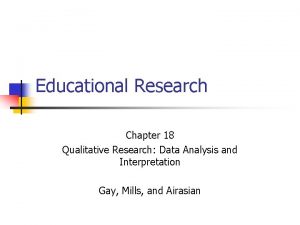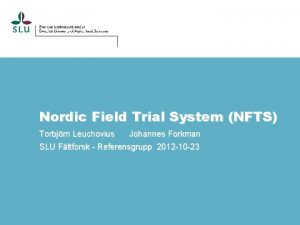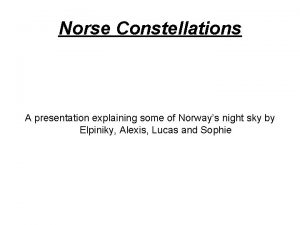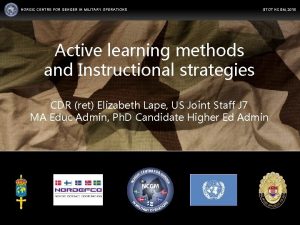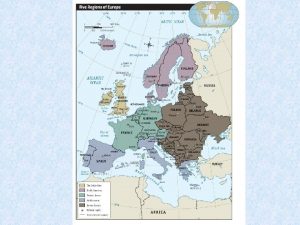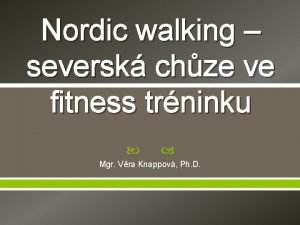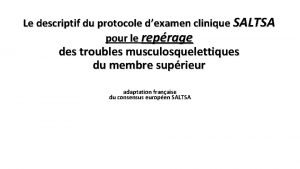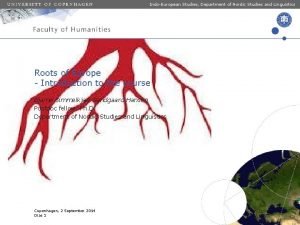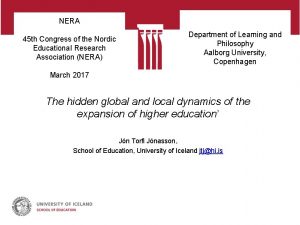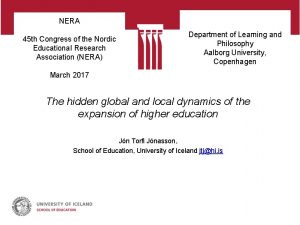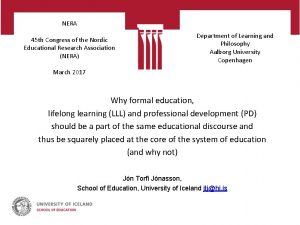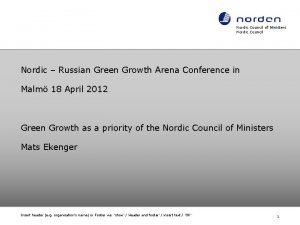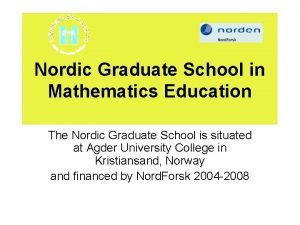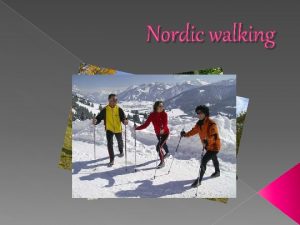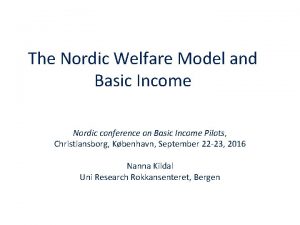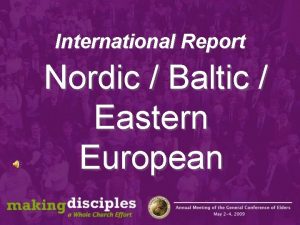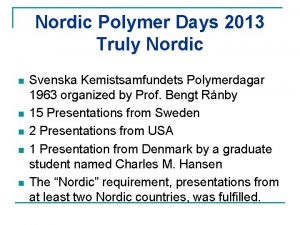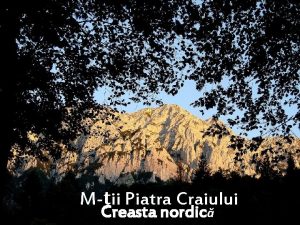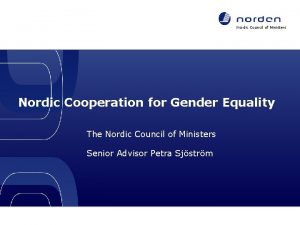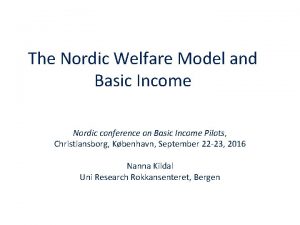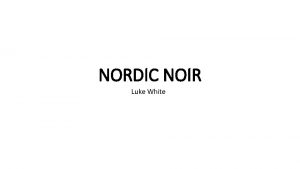NERA the Nordic Educational Research Association School of















































- Slides: 47

NERA, the Nordic Educational Research Association School of Education at the University of Iceland Reykjavík 7 -9 March 2013 Is there a Nordic invariance in HE educational development – from the perspective of gender and cohorts? Jón Torfi Jónasson, School of Education, University of Iceland jtj@hi. is Aimee Haley, School of Education, University of Iceland , Jón Torfi Jónasson Aimee Haley NERA Iceland 2013 1

The abstract Jónasson (2011) argued that from a global perspective there are clear signs of important similarities between the expansion of very different educational systems and relating this the discussion of global expansion (Schofer & Meyer, 2005). It has already been shown that there is considerable affinity between educational expansion at the Nordic upper secondary level (Jónasson, 2003) and the higher educational level as well (Jónasson, 2004). The paper will explore data from all the Nordic countries showing the development for both sexes and for individual cohorts in the range 22 -39 and for the different degree levels (although the time-series on this are limited in scope). The dependent variables in the analysis are both enrolment numbers and graduation rates. The available time series typically extend back to the 1970 s, but in some cases further back. The similarities and differences between the Nordic systems will be explored from the perspective of these variables. By analysing the variance between the growth characteristics and index of similarity will be discussed. A range of methodological problems will be discussed, inter alia those related to classifying the different HE institutions, and the inclusion of foreign students and students studying abroad. Jón Torfi Jónasson Aimee Haley NERA Iceland 2013 2

Gender The gender perspective and the gender gap – The gender gap within the Nordic countries and compared to other countries? – How might the gender gap be interpreted? – The gender story: my observation is that there is a common misconception that there is a gender gap that will at some time close or there is a temporary “overshooting” by the females. But if one looks closely at the trends, the growth of female participation has been different for males and females for a whole century, and the rates of growth were the same while females were much fewer or a majority. This can be underpinned by looking at the growth rates for cohorts which gives a robust picture of the pattern of growth and the invariance within and between the sexes. Jón Torfi Jónasson Aimee Haley NERA Iceland 2013 3

HE education growing on a world scale Based on Schofer and Meyer 2005 Jón Torfi Jónasson Aimee Haley NERA Iceland 2013 4

Jón Torfi Jónasson Aimee Haley NERA Iceland 2013 5

Jón Torfi Jónasson Aimee Haley NERA Iceland 2013 6

Jón Torfi Jónasson Aimee Haley NERA Iceland 2013 7

Jón Torfi Jónasson Aimee Haley NERA Iceland 2013 8

Comparative growth rates, time and gender Jón Torfi Jónasson Aimee Haley NERA Iceland 2013 9

“We also explored gender differences in participation by looking at disaggregated tertiary enrollment ratios, which are available in the post -war era. Figure 5 presents the global average of enrollment ratios for independent nations from 1950 to 2000. At the start of the period, higher education enrollment ratios were quite low: just over 2 percent for men and less than 1 percent for women in the average country. The initial expansion disproportionately involved men, increasing the gender gap from about 1. 5 points to over 3 points. In raw terms, however, the gap begins to shrink starting after 1970, and parity is achieved around 1990. By 2000 the average female enrollment ratio is higher than the male average by 6 points, a difference of almost 25 percent. It is noteworthy that the “new gender gap, ” which has recently been observed in studies of industrialized countries, is also evident in our global averages. The overall trend, however, is similar for men and women. Enrollment ratios grow by more than an order of magnitude over the period, dwarfing the between-gender differences. “ p. 909. • The Worldwide Expansion of Higher Education in the Twentieth Century. Evan Schofer and John W. Meyer American Sociological Review. December 2005 vol. 70 no. 6 898 -920 doi: 10. 1177/000312240507000602 Jón Torfi Jónasson Aimee Haley NERA Iceland 2013 10

“We also explored gender differences. . . from 1950 to 2000. At the start of the period, higher education enrollment ratios were. . . just over 2 percent for men and less than 1 percent for women in the average country. The initial expansion disproportionately involved men, increasing the gender gap from about 1. 5 points to over 3 points. In raw terms, however, the gap begins to shrink starting after 1970, and parity is achieved around 1990. By 2000 the average female enrollment ratio is higher than the male average by 6 points, a difference of almost 25 percent. It is noteworthy that the “new gender gap, ” which has recently been observed in studies of industrialized countries, is also evident in our global averages. The overall trend, however, is similar for men and women. Enrollment ratios grow by more than an order of magnitude over the period, dwarfing the between-gender differences. “ p. 909. Jón Torfi Jónasson Aimee Haley NERA Iceland 2013 11

Imagine the 20 th century The percentage of cohort enrolled in HE Males 2% Growth rate 3, 5% Females 0, 1% Growth rate 6% a) Look at increments in the early years; which are bigger? b) Look at the parity point, near 1980 c) Look at the growth after parity is reached d) Note that a saturation curve is not shown, even though it should be Jón Torfi Jónasson Aimee Haley NERA Iceland 2013 12

Jón Torfi Jónasson Aimee Haley NERA Iceland 2013 13

Jón Torfi Jónasson Aimee Haley NERA Iceland 2013 14

Jón Torfi Jónasson Aimee Haley NERA Iceland 2013 15

Jón Torfi Jónasson Aimee Haley NERA Iceland 2013 16

Provisional conclusion: a) The gender gap may sometimes be fundamentally misinterpreted. It is most simply interpreted as the growth of two quite distinct populations, with different aspirations and interests. They operate as if in two different education systems. (See also Jónasson, 2003, for upper secondary education in the Nordic countries. ) b) This story is used to motivate the use of the growth coefficient in subsequent analysis. Jón Torfi Jónasson Aimee Haley NERA Iceland 2013 17

Age The expansion of education and the age of HE students – How might cohort developments be interpreted? And what do they tell us about the HE system? The age story: it is suggested that the growth of HE cannot be well understood until the growth of the different cohorts is analysed, preferably at different degree levels, where the gradual increased prevalence at the higher age levels comes to light. The consistence across cohorts also underpins a thesis that the growth is best described by an exponential curve, which fits with a credential story (looking at credentials as a consumable). Note that the notion that HE education is attended by people in their early twenties is, by now, totally mistaken. Jón Torfi Jónasson Aimee Haley NERA Iceland 2013 18

The age of students in Nordic HE (ISCED 5 and 6) % distribution (2010) Jón Torfi Jónasson Aimee Haley NERA Iceland 2013 19

Jón Torfi Jónasson Aimee Haley NERA Iceland 2013 20

Jón Torfi Jónasson Aimee Haley NERA Iceland 2013 21

Jón Torfi Jónasson Aimee Haley NERA Iceland 2013 22

Jón Torfi Jónasson Aimee Haley NERA Iceland 2013 23

Jón Torfi Jónasson Aimee Haley NERA Iceland 2013 24

Jón Torfi Jónasson Aimee Haley NERA Iceland 2013 25

Jón Torfi Jónasson Aimee Haley NERA Iceland 2013 26

Jón Torfi Jónasson Aimee Haley NERA Iceland 2013 27

Jón Torfi Jónasson Aimee Haley NERA Iceland 2013 28

Invariance a) Invariance is a relative term b) Invariance and Nordic invariance – Are the Nordic countries similar to each other in the way HE grows? – Are the Nordic countries in some way different from other countries? Jón Torfi Jónasson Aimee Haley NERA Iceland 2013 29

Expansion of HE systems – The Nordic countries Jón Torfi Jónasson Aimee Haley NERA Iceland 2013 30

OECD Using OECD data as reference material a) Enrolment corrected for cohort size b) Growth coefficients c) Problem: Short time series Jón Torfi Jónasson Aimee Haley NERA Iceland 2013 31

Jón Torfi Jónasson Aimee Haley NERA Iceland 2013 32

Jón Torfi Jónasson Aimee Haley NERA Iceland 2013 33

Jón Torfi Jónasson Aimee Haley NERA Iceland 2013 34

Jón Torfi Jónasson Aimee Haley NERA Iceland 2013 35

Institutions Institutional difference The expansion of education within types of education – How do the above patterns apply to different levels of HE? The data for different institutions will throw light on a suggestion that a strong force pushing the colleges towards universities may be largely due to the students voting with their feet. They want vocational or professional degrees, but only provided that their status is high enough. So if the status differential is too high (as they perceive it) they prefer the university even if they would prefer the professional degree. The only response to this is to enhance the status of the institutions giving the professional degrees. Here the reference is to implicit mechanisms that can only be discerned if one looks at trends over very long times. Jón Torfi Jónasson Aimee Haley NERA Iceland 2013 36

Jón Torfi Jónasson Aimee Haley NERA Iceland 2013 37

Jón Torfi Jónasson Aimee Haley NERA Iceland 2013 38

Conclusions a) Gender patterns are sensibly interpreted as robust invariant growth, different for the two sexes b) Apparently not different in the Nordic countries from what can be seen in a number of other countries, neither in terms of absolute enrolment numbers, gender differences or growth coefficients. c) Growth of older cohorts is noticeable but apparently not special for the Nordic countries. d) There are signs of institutional differences in terms of growth rates, but it is not clear if there is anything specially Nordic in this respect. e) There are signs that the gender, age and institutional patterns are in essence universal, even though there are quite sizable country variations. Jón Torfi Jónasson Aimee Haley NERA Iceland 2013 39

Thank you Jón Torfi Jónasson Aimee Haley NERA Iceland 2013 40

Expansion of HE systems – Three different systems Jón Torfi Jónasson Aimee Haley NERA Iceland 2013 41

Sweden: Examination profiles 1978 -2004 for different female age groups: First examination 160 poang or more (four years or more) Jón Torfi Jónasson Aimee Haley NERA Iceland 2013 42

Sweden: Examination profiles 1978 -2004 for different female age groups: First examination 160 poang or more (four years or more) Jón Torfi Jónasson Aimee Haley NERA Iceland 2013 43

Sweden: Growth coefficients for examination profiles 1978 -2004 for different female and male age groups: First examination 160 poang or more (four years or more) Jón Torfi Jónasson Aimee Haley NERA Iceland 2013 44

Sweden: Growth coefficients for examination profiles 1978 -2004 for different female and male age groups: Three different levels of examination Jón Torfi Jónasson Aimee Haley NERA Iceland 2013 45

Iceland: Growth coefficients for enrolment profiles 1978 -2004 for different female and male age groups: Examination level ISCED 76 level 6 Jón Torfi Jónasson Aimee Haley NERA Iceland 2013 46

Iceland: Growth coefficients for enrolment profiles 1978 -2004 for different female and male age groups: Examination level ISCED 76 levels 6 and 7 Jón Torfi Jónasson Aimee Haley NERA Iceland 2013 47
 California educational research association
California educational research association Faccetta nera note scritte
Faccetta nera note scritte Nera inspection
Nera inspection Nera plant produkte kaufen
Nera plant produkte kaufen Gavrilo princip mano nera
Gavrilo princip mano nera Nuclei della base
Nuclei della base La pecoranera
La pecoranera Dirbtiniai šviesos šaltiniai
Dirbtiniai šviesos šaltiniai Kodėl mėnulis nelaikomas gamtiniu šviesos šaltiniu
Kodėl mėnulis nelaikomas gamtiniu šviesos šaltiniu Dirbtiniai šviesos šaltiniai
Dirbtiniai šviesos šaltiniai Ceap
Ceap Georgia association of educational leaders
Georgia association of educational leaders Research design for qualitative research
Research design for qualitative research Primary reliance on researcher to deal with procedural bias
Primary reliance on researcher to deal with procedural bias State council of educational research and training
State council of educational research and training Educational research gay
Educational research gay Gay nnn
Gay nnn Educational research and development
Educational research and development Introduction to educational research mertler
Introduction to educational research mertler Types of educational research
Types of educational research Hong kong institute of educational research
Hong kong institute of educational research Interpretation of data sample
Interpretation of data sample Nordic field trial system
Nordic field trial system Nordic field trial system
Nordic field trial system Nordic innovation centre
Nordic innovation centre The nordic combat uniform
The nordic combat uniform Dhl parcel nordic
Dhl parcel nordic British isles and nordic nations map
British isles and nordic nations map Nordic choice club
Nordic choice club Westfjord 29 nordic
Westfjord 29 nordic Nooksack nordic ski club
Nooksack nordic ski club Zonenweitsprung kinder
Zonenweitsprung kinder Nordic apples
Nordic apples Thiazi's eyes constellation
Thiazi's eyes constellation Nordic ecolabel criteria
Nordic ecolabel criteria Nordic centre for gender in military operations
Nordic centre for gender in military operations British isles and nordic nations map
British isles and nordic nations map Kuesioner nordic body map
Kuesioner nordic body map Nordic walking benefits
Nordic walking benefits Nordic changemaker map
Nordic changemaker map Nordic walking wymowa po polsku
Nordic walking wymowa po polsku Nordic-backup
Nordic-backup Nordic navigation
Nordic navigation Rsmp protocol
Rsmp protocol Nordic trout
Nordic trout Kuorinka nordic questionnaire
Kuorinka nordic questionnaire European and nordic studies
European and nordic studies Nordic osint
Nordic osint
